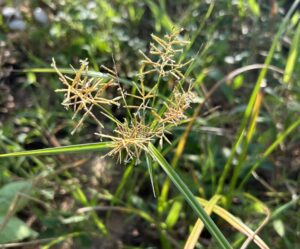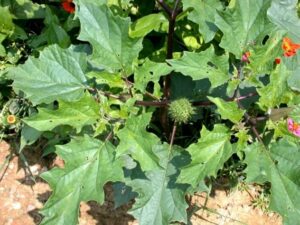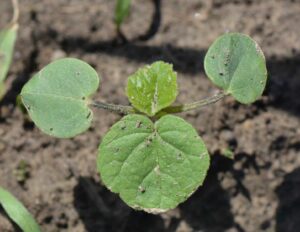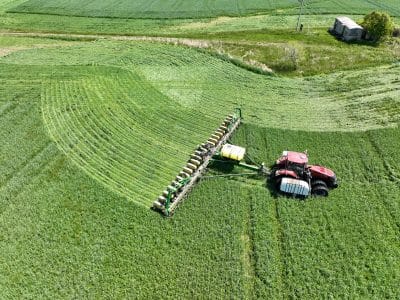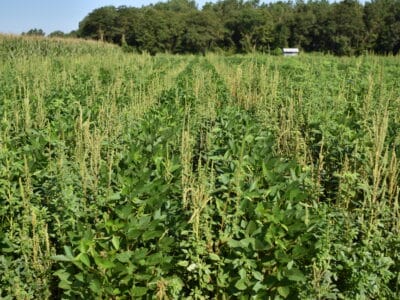Chenopodium album L.
Also known as fat hen, lambsquarters goosefoot, white goosefoot

Biology
Common lambsquarters is an upright, summer annual weed inhabiting a wide range of environments. It can attain a height of four feet or more and has large variations in appearance. Leaves often have the outline of a goosefoot. Mature plants produce two different types of seeds with different characteristics. The majority of the seeds are black, small, and round, while a small percentage of seeds are brown and oblong in shape. The black seeds are dormant at maturity while brown seeds are non-dormant at maturity. Long summer days favor the production of black seeds while short fall days increase the percentage of brown seeds.
Common lambsquarters is a troublesome weed due its early-season germination, rapid growth, ability to produce a large number of seeds that persist in the seedbank for many years, and adaptation to a wide range of environmental conditions. However, the leaves can be eaten as a vegetable and seeds, sometimes called “wild quinoa”, can be harvested for grain.
Under hot and dry environmental conditions, common lambsquarters respond by producing thick epicuticular wax to conserve moisture. This thick wax on the leaves appears to reduce the uptake of foliar herbicides and may lead to some of the reports of inconsistent control.
Where is common lambsquarters a problem?
Its native range was thought to be Europe, but seeds have been found at pre-European archeological sites in North America. It is one of the most economically important weeds in the world and has been identified by farmers and researchers as one of the most common and troublesome weeds in North American corn, spring-seeded cereals, and early-planted broadleaf crops. While common lambsquarters may not be as aggressive as some other weed species, at high densities it can cause up to 25% soybean yield loss and over 50% corn yield loss.
Common lambsquarters is found in tilled and non-tilled agricultural fields, roadsides, and other disturbed sites throughout the US and Canada. Common lambsquarters can be found in most soil types, tolerating a wide range of soil pH and fertility levels. However, it grows best in rich fertile soils, which favor its seed production. It is used by some as an indicator of good soil.
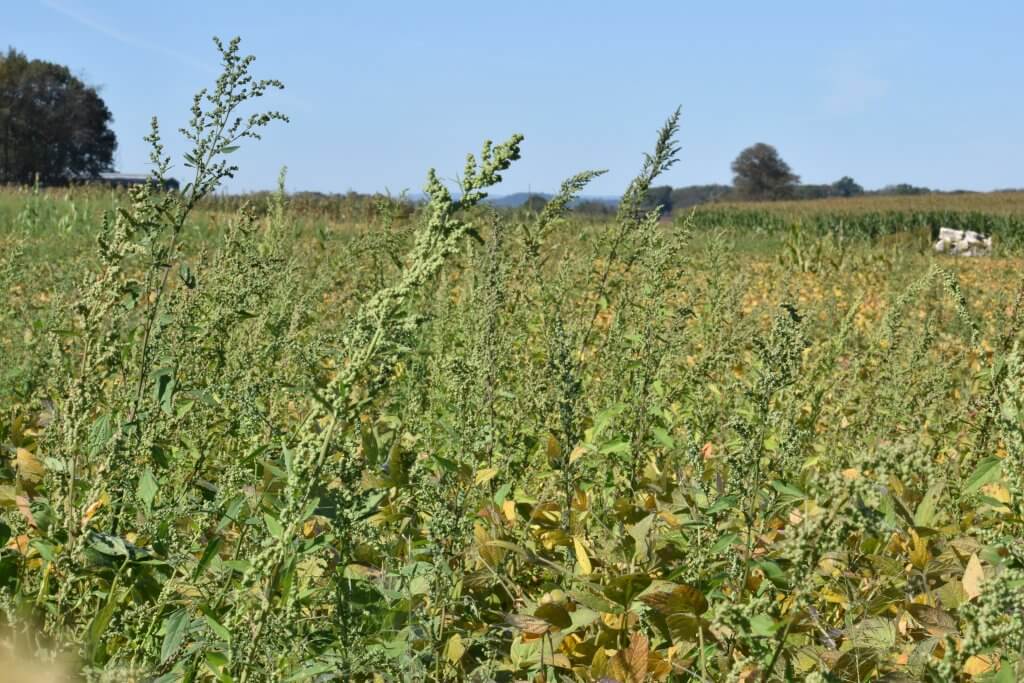
What is the emergence pattern of common lambsquarters?
Common lambsquarters is an early emerging species, starting before many other summer annual species. The emergence period for common lambsquarters is relatively short, with most seedlings emerging by early summer. Seed germination is favored by light exposure, day/night temperature fluctuations, and the presence of nitrate in the soil, all of which can be influenced by soil disturbance/tillage. Warm soil temperatures tend to slow or stop germination.
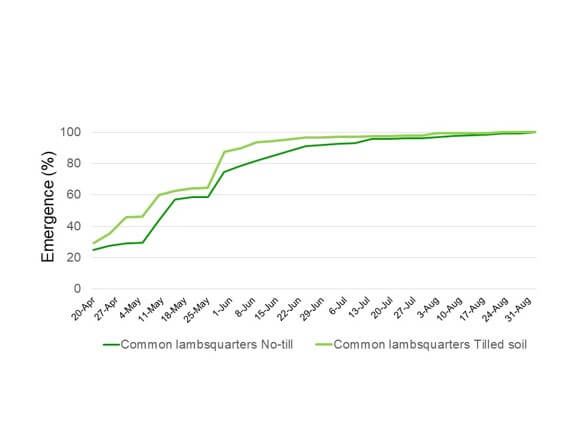
What is the lifecycle of a common lambsquarters plant?
In the United States, common lambsquarters germinate in early spring, reaching peak height and biomass by early July, and flowers through July into August, with accelerated maturity observed under warm conditions. The earliest seeds mature by early August with production and dispersal continuing through late summer and fall.
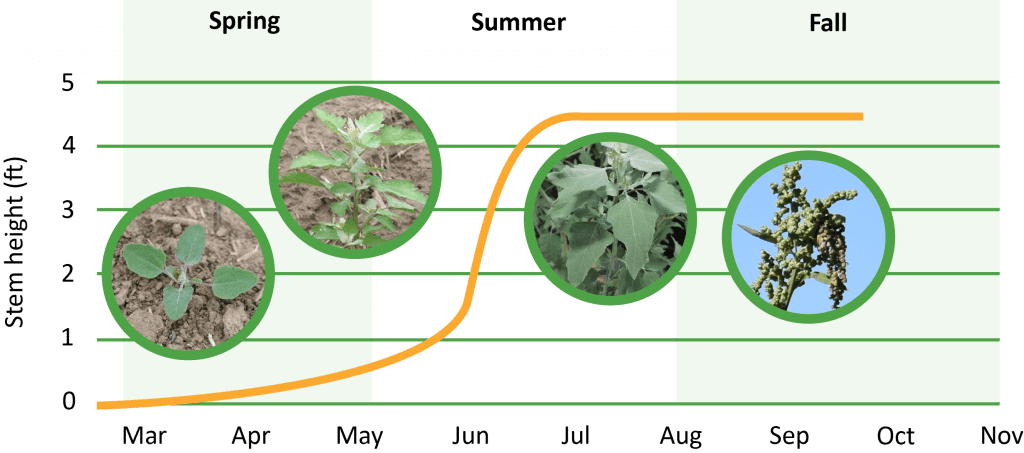
How does common lambsquarters spread?
As an annual species, common lambsquarters spread by seed; the seeds do not have any special mechanism for dispersal. Mature seeds are released when the parent plant is disturbed and fall within one or two feet of the mother plant. Seed shatters readily at maturity and thus care should be taken when removing mature plants from the field to prevent seed spread. Up to 10% of common lambsquarters seed shatters by soybean maturity and up to 50% four weeks past maturity, so seed dispersal through combines should be prevented.
Common lambsquarters seeds can survive the digestive tract of most livestock, so manure can be a source of new infestations. Commercial bird-feed has also been identified as a source of common lambsquarters dispersal.
How many seeds can a common lambsquarters plant produce and how long can those seeds survive?
Seed production per plant is relatively high, with a few studies reporting up to 500,000 seeds/plant; most sources cite 70,000 to 100,000 seeds/plant.
Common lambsquarters seeds remain viable in the soil for a relatively long period of time. Studies have reported that 50% of the seeds were still viable after 12 years in the soil and projected that it would take 78 years to achieve 99% seed mortality. As burial depth increases, seed dormancy and longevity increase.
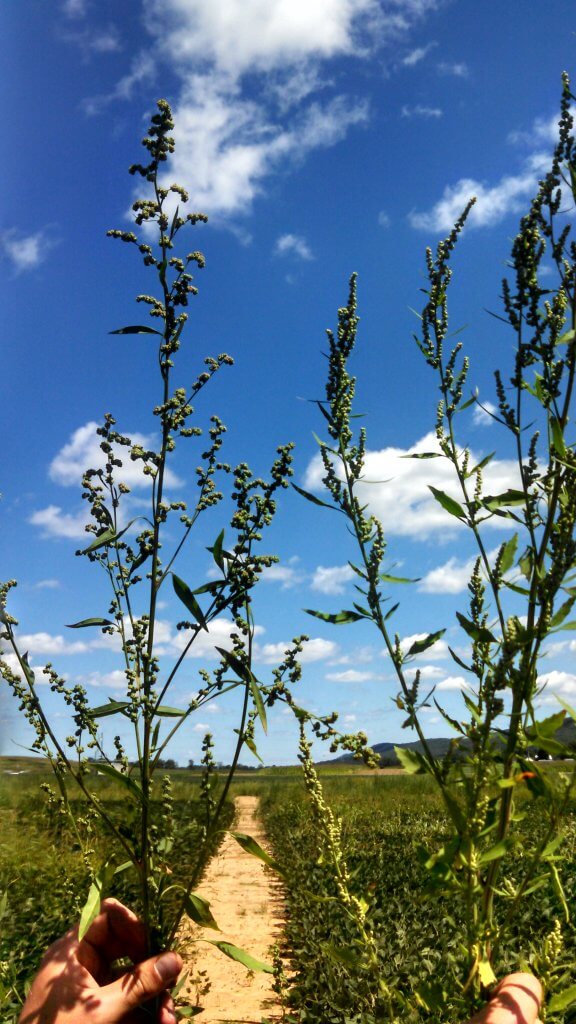
What other biological weaknesses does common lambsquarters have that can be targeted with management techniques?
Seed size of common lambsquarters is small and so it needs to be within 0.5 to 1 inch of the soil surface to germinate and emerge. Deep inversion tillage can bury common lambsquarters seeds too deep to germinate. However, repeated tillage can move seeds buried back to the soil surface.
The short germination period of common lambsquarter makes it well suited for stale (or false) seedbeds. Additionally, seeds are often retained at crop harvest, making it susceptible to harvest weed seed control. Both tactics are described below under Mechanical Control.

Herbicide Resistance
Common lambsquarters was one of the first species with documented herbicide resistance when triazine (group 5) resistance was reported in 1975; resistance quickly spread across the northern US Corn Belt. Glyphosate-resistant common lambsquarters have not been documented. However, there are populations of common lambsquarters that exhibit a range of susceptibility to glyphosate.

*Herbicide names listed are representative products that contain specific active ingredients. Last updated on: 2-11-2022
Integrated Weed Management Strategies for Control
Cultural practices that result in a rapid development of the crop canopy will improve weed control. Reducing row spacing or increasing seeding rate of soybeans or sorghum, thereby promoting early canopy closure, will increase crop competitiveness and improve overall weed management.
Common lambsquarters emergence is often enhanced by exposure to light. Research has tried to reduce or eliminate light exposure to seeds during tillage. Tilling at night (dark tillage) can reduce common lambsquarters emergence by 30 to 70%.
Given that common lambsquarters emerges early in the spring and does not have a prolonged germination period, delaying planting until early summer allows the majority of plants to emerge and be killed with tillage or non-selective herbicides prior to planting.
The addition of small grains or another fall-seeded crop to the crop rotation helps suppress common lambsquarters, since very few plants will emerge after small grain harvest. In regions where small grains are double-cropped with soybean, this practice can improve common lambsquarters management. Competition from the small grain reduces seedling emergence and growth and the non-selective herbicide at soybean planting eliminates any emerged seedlings; very little additional seedling emergence will occur.
A fall-planted cover crop can reduce common lambsquarters emergence and early-season growth by shading the soil. However, since common lambsquarters emerges early in the spring, sufficient biomass needs to be present to maximize its effectiveness. If the cover crop is not terminated until soon before planting (two week prior to planting or sooner), the dead cover crop will also continue to shade the ground and provide a physical barrier for seedlings to grow through. Mechanical termination of the cover crop will be less effective for common lambsquarters control, since many seedlings can emerge before the cover crop is
rolled and the roller crimper will not kill seedlings. The seedlings will often find a gap in the rolled cover crop, grow through it, and compete with the cash crop. A chemical method of cover crop termination is preferred when controlling emerged common lambsquarters in the spring.
Common lambsquarters has a strong response to nitrogen, so nitrogen application should be timed and placed (i.e., banded in the crop row instead of broadcast) to maximize cash crop response and minimize any competitive advantage to common lambsquarters. In practice, this means soybeans, particularly in combination with a grass cover crop, can create a situation that minimizes nitrogen availability to common lambsquarters. Legume cover crops can also deplete common lambsquarters seedbanks by stimulating fatal germination.
Mechanical weed control with pre-plant tillage can be a key component of an integrated approach. Moldboard plowing or inversion tillage is an effective method of controlling common lambsquarters because seeds will not germinate/emerge when buried deeper than two inches under the soil surface. However, repeated inversion of the soil will move previously buried seeds to the soil surface where they can germinate. Due to common lambsquarters’ long dormancy period, a larger proportion of buried seeds remain viable when returned to the soil surface than other species. Aggressive tillage is most effective in late spring prior to planting but after the main flush of common lambsquarters has germinated. This allows the crop to be planted into weed-free conditions. Stale-seedbeds (or false-seedbeds) can be an effective strategy to manage common lambsquarters due to its early and short germination period.
Tillage system modifications have had inconsistent results for common lambsquarters emergence. In some studies, more seedlings emerged in tilled plots compared to no-tillage, but the results were reversed the next season. Over a four-year period, tillage had very little effect on seedling emergence patterns (Figure 1).
Cultivation after planting can control later emerging common lambsquarters. Blind tillage and interrow cultivation are very effective on plants in the seedling stage. Shallow cultivation is preferred for common lambsquarters control to prevent previously buried seeds from being brought into contact with favorable conditions for germination at the soil surface. Common lambsquarters have small seeds, and with its limited energy reserves it is quite sensitive to mechanical weed control.
Mowing nearby roadsides could also decrease the prevalence of common lambsquarters. Mowing nearby roadsides once may not be enough to completely eliminate seed production, but common lambsquarters are more susceptible to mowing than many other species.
Common lambsquarters plants produce a large number of long-lived seeds, so removing plants that survive early-season control tactics is important for long-term management. Seeds are viable within 2-3 weeks of flowering and can continue to mature even if plants are killed by mowing or other methods, so in late summer and fall, these plants will need to be removed from the field to prevent seed from entering the soil seedbank.
Harvest weed seed control (HWSC) is likely helpful for management of common lambsquarters. Common lambsquarters has higher rates of seed shatter than some weed species such as pigweeds/Palmer amaranth/waterhemp, but up to 90% of common lambsquarters seed remains on the plant at soybean harvest, allowing HWSC to greatly reduce the amount of seed entering the seedbank when a timely harvest occurs.
Chemical control based on an effective herbicide program for common lambsquarters requires full-labeled rates and applications at the correct timing. Plant into a weed-free field, using an effective non-selective herbicide prior to planting or using tillage just prior to planting. Preemergence or residual (or soil-applied) herbicides should be applied close to crop planting to provide maximum amount of residual control after planting. Group 15 herbicides (S-metolachlor, pyroxasulfone, and acetochlor) are often rated fair to good for common lambsquarters control. Combinations of Group 14, 15, or 5 should provide good residual control in soybean. Even effective residual herbicides will only provide 3-5 weeks of residual control depending on herbicide, soil type, rainfall, and soil temperatures. Postemergence applications need to be applied to common lambsquarters seedlings up to four inches in height. Applications to taller plants do not provide consistent control. While not documented to be resistant, glyphosate alone may not reliably control common lambsquarters. Consider tank-mixing with postemergence herbicides belonging to Group 2 in soybean. Liberty (Group 10) is effective on common lambsquarters less than 4 inches tall in LibertyLink, Enlist, or Xtendflex soybean.
For more information on chemical common lambsquarters management, visit:

Biological control products are not currently available for common lambsquarters. Seeds on (or near) the soil surface are often consumed by rodents and invertebrates, and ground cover can increase the density of these seed predators.
Similar Weed Species
There are at least sixteen Chenopodium species across the US Corn Belt; many of them are similar in appearance to common lambsquarters. These species include oakleaf goosefoot (Chenopodium glaucum L.), narrow-leaved goosefoot (Chenopodium pratericola Rydb.), pitseed goosefoot (Chenopodium berlandieri Moq.), and spreading orach (Atriplex patula L.). Young common lambsquarters can be distinguished from closely related or similar-looking weeds by a powdery silver to pink coating on the earliest true leaves.
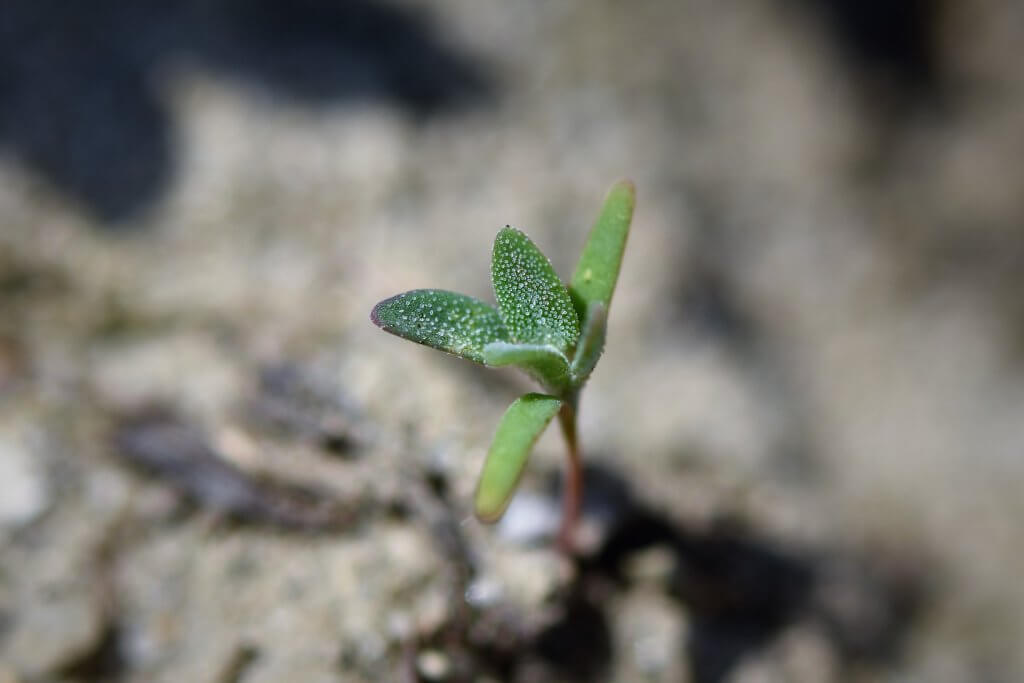
Author:
- Eugene Law
Editors:
- Victoria Ackroyd
- Kreshnik Bejleri
- Michael Flessner
- Lauren Lazaro
- Steven Mirsky
- Claudio Rubione
- Mark VanGessel
Reviewed by:
- Erin Burns
- Prashant Jha
Resources
Michigan State University Extension. Michigan’s Worst Weeds: Common Lambsquarters, https://www.canr.msu.edu/weeds/extension/common-lambsquarters. Accessed February 12, 2021
Mohler CL, Teasdale JR, DiTommaso A (2021) Common lambsquarters. Pages 251-254 in Mohler CL, Teasdale JR, DiTommaso A, eds. Manage Weeds On Your Farm: a guide to ecological strategies. USDA-SARE Handbook Series 16 https://www.sare.org/resources/manage-weeds-on-your-farm/
Take Action: Common Lambsquarters: https://growiwm.org/factsheets/https-growiwm-org-wp-content-uploads-2024-12-updated-factsheet-lambsquarters-nov-2024-pdf/
Van Wychen L (2020) Survey of the most common and troublesome weeds in grass crops, pasture, and turf in the United States and Canada. Weed Science Society of America National Weed Survey Dataset. Available: https://wssa.net/wp-content/uploads/2020-Weed-Survey_grass-crops.xlsx
Van Wychen L (2019) Survey of the most common and troublesome weeds in broadleaf crops, fruits and vegetables in the United States and Canada. Weed Science Society of America National Weed Survey Dataset. Available: https://wssa.net/wp-content/uploads/2019-Weed-Survey_broadleaf-crops.xlsx
Citations
Bassett IJ, Crompton CW (1978) The biology of Canadian weeds. 32 Chenopodium album L. Canadian Journal of Plant Science 58:1061-1072 doi.org/10.4141/cjps78-161
Blubaugh CK and Kaplan I (2016) Invertebrate seed predators reduce weed emergence following seed rain. Weed Science 64:80-6:10 doi.org/10.1614/WS-D-15-00111.1
Fischer DW, Harvey RG, Bauman TT, Phillips S, Hart SE, Johnson GA, Kells JJ, Westra P, Lindquist J (2004) Common lambsquarters (Chenopodium album) interference with corn across the northcentral United States. Weed Science 52:1034 – 1038 doi.org/10.1614/P2000-172
Oseland E, Bish M, Spinka C, Bradley K (2020) Examination of commercially available bird feed for weed seed contaminants. Invasive Plant Science and Management 13:14-22 doi.org/10.1017/inp.2020.2
Schwartz-Lazaro L, Shergil, L, Evans J, Bagavathiannan M, Beam S, Bish M, . . . Mirsky S (2021) Seed-shattering phenology at soybean harvest of economically important weeds in multiple regions of the United States. Part 1: broadleaf species. Weed Science 69:95-103 doi.org/10.1017/wsc.2020.80
Gallery























